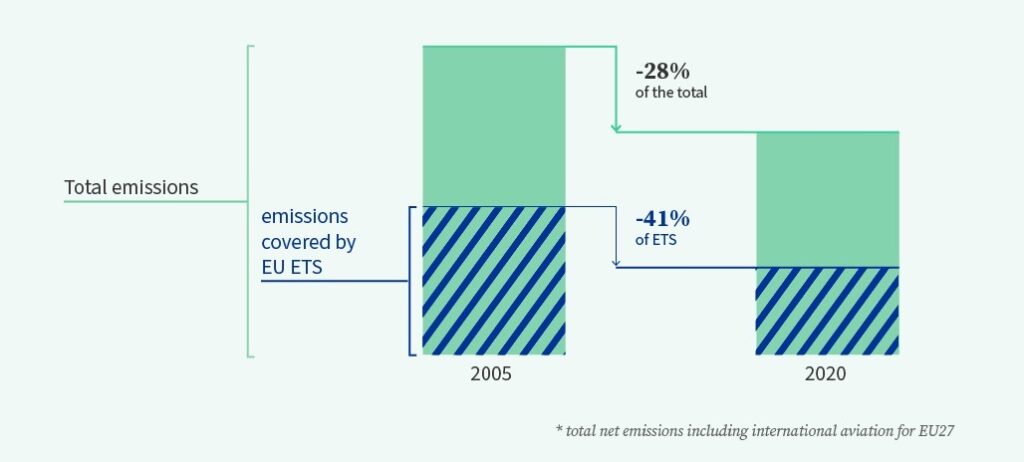This article originate from my contributions to Energiris, a Belgian citizens’ cooperative committed to accelerating the energy transition. As part of our mission to inform and raise awareness among both co-owners and the general public, we regularly publish educational content on topics related to sustainable energy.
The original article was published in French and Dutch, reflecting the multilingual context of our cooperative. By sharing them here in English, I also wish to reflect my personal commitment to a more sustainable and better-informed society.
The European Union is preparing to introduce a new carbon pricing system, known as ETS2 (Emissions Trading System 2), which will come into force in 2027. This initiative aims to reduce greenhouse gas emissions and encourage a transition to more sustainable energy sources. Here is an overview of what this means for Belgium.
What is the ETS?
The EU Emissions Trading System (ETS) is a central pillar of the European Union’s climate policy. Launched in 2005, it is the world’s first carbon market and one of the largest. The ETS is based on the “cap and trade” principle:
- Cap: A cap is set on the total greenhouse gas emissions allowed for installations and operators covered by the system. This cap is reduced each year in line with the EU’s climate targets, ensuring a gradual reduction in overall emissions.
- Trading: Companies receive or purchase emission allowances, which they can trade among themselves as needed. Each allowance allows for the emission of one tonne of CO₂ equivalent. Companies must monitor and report their annual emissions and surrender enough allowances to cover their emissions. Failure to do so results in severe fines.
The price of allowances is determined by the EU carbon market, which encourages companies to reduce their emissions in a cost-effective manner. Since 2013, the ETS has generated more than €175 billion in revenue, mainly used to support investments in renewable energy, energy efficiency and low-carbon technologies.
Want to learn more? This video explains it all in a fun way.
What is ETS2?
ETS2 is an extension of the existing EU emissions trading system, ETS1, which already covers major industries and the aviation sector.
Currently, ETS1 covers nearly 10,000 companies within the European Union and accounts for 40% of total EU emissions. The European trading system (ETS1) has already reduced our emissions by 28% overall.

However, this system is set to be revised and the ETS will extend its coverage to other sectors, such as construction and transport.
The European ETS2 directive was proposed by the European Commission in July 2021 as part of the ‘Fit for 55’ legislative package. It was approved by MEPs on 22 June 20221. The system will become fully operational in 2027 and will apply to fossil fuels used for heating buildings and mobility, including private cars.
Objectives of ETS2
The main objective of ETS2 is to contribute to the achievement of the EU’s climate targets, including a 55% reduction in greenhouse gas emissions by 2030 and carbon neutrality by 2050. By gradually increasing the cost of fossil fuels, ETS2 encourages consumers and businesses to switch to greener alternatives.
Who is affected?
ETS2 will mainly affect fossil fuel suppliers, who will have to purchase emission allowances for every tonne of CO₂ they emit. However, these additional costs are likely to be passed on to end consumers, affecting households and businesses.
Implications for Belgian households
For Belgian households, ETS2 could lead to a significant increase in heating and fuel costs. According to some estimates, the annual bill could increase by an average of €600. The price of diesel, petrol, heating oil and natural gas is also expected to rise, making fossil fuels less attractive compared to renewable alternatives.
Consequences and accompanying measures
In order to limit the financial impact on households, the EU plans to create a Social Climate Fund, which will be set up in 2026. This fund, financed by part of the ETS2 revenues, aims to support vulnerable households and finance energy renovation projects. In Belgium, this fund could represent around €2 billion over the period 2026-2032.
Alternatives to fossil fuels exist
To reduce dependence on fossil fuels, several renewable alternatives are available:
- Solar energy: Use of photovoltaic panels to generate electricity. In residential buildings, solar-generated electricity can be used for both heating and mobility.
- Wind energy: Harnessing the power of the wind via wind turbines.
- Geothermal energy: Using the Earth’s heat for heating and electricity generation.
- Biomass: Converting organic matter into energy.
- Hydroelectricity: Generating electricity from moving water.
How can you reduce your personal carbon footprint?
Here are some concrete actions you can take to reduce your carbon footprint:
- Improve the insulation of your home: Reduce your heating and air conditioning needs.
- Use environmentally friendly modes of transport: Walk, cycle, use public transport or carpool.
- Adopt a more responsible diet: Reduce meat consumption and choose local and seasonal products.
- Reduce air travel: Opt for local holidays or use less polluting means of transport.
- Choose green energy suppliers: Opt for electricity contracts from renewable sources.
Energiris’ contribution to reducing the carbon footprint in Belgium and Brussels
Energiris is a citizen cooperative that plays a crucial role in the energy transition in Belgium, particularly in Brussels. Founded in 2014, Energiris now has more than 550 members who invest in sustainable energy projects. To date, the cooperative has financed 63 projects, representing a total investment of €8.6 million.
The projects financed by Energiris include the installation of solar panels, improving the energy efficiency of buildings, and other initiatives aimed at reducing fossil fuel consumption. These projects enable the production or saving of green energy equivalent to the consumption of 2,400 households1.
In Brussels, Energiris is helping to achieve the green electricity production targets set by the Brussels government. The cooperative aims to achieve a 2% market share in sustainable energy investments, or around €52 million by 2035. By involving citizens in the financing of these projects, Energiris is promoting an inclusive and participatory energy transition.
How households can limit the impact of ETS2
To mitigate the financial impact of ETS2, households can adopt several strategies:
- Energy renovation: Invest in thermal insulation, replace windows with double-glazed models, and install more efficient heating systems such as heat pumps.
- Use of renewable energy: Install solar panels or domestic wind turbines to generate green electricity.
- Optimisation of energy consumption: Use energy-efficient household appliances and adopt energy-saving behaviours, such as turning off lights and appliances when not in use.
- Sustainable mobility: Switch to electric or hybrid vehicles, use public transport, carpooling or cycling for daily travel.
- Participation in support programmes: Take advantage of subsidies and financial assistance offered by the Social Climate Fund to finance energy renovation projects and reduce initial costs.
In conclusion, ETS2 represents a crucial step in the fight against climate change in Europe. Although this measure may entail additional costs for households, it also offers an opportunity to transition to more sustainable energy sources and reduce our carbon footprint in the long term. Thanks to initiatives such as those of Energiris, citizens can play an active role in this transition and contribute to a greener future.
Bibliography, if you would like to learn more about this topic:
- Chanvry, E. (2024, 18 septembre). Les énergies renouvelables peuvent-elles remplacer les ressources fossiles ? Hello Watt. https://www.hellowatt.fr/blog/ressources-fossiles-renouvelables/
- Deluzarche, C. (2024, 3 juin). Réduire son empreinte carbone : 6 moyens (vraiment) efficaces. Futura. https://www.futura-sciences.com/planete/questions-reponses/eco-consommation-reduire-son-empreinte-carbone-6-moyens-vraiment-efficaces-11234/
- Énergies fossiles : avantages, inconvénients et alternatives. (2023, 14 décembre). https://greenly.earth/fr-fr/blog/actualites-ecologie/energies-fossiles-avantages-inconvenients-et-alternatives
- EU Emissions Trading System (EU ETS). (s. d.). Climate Action. https://climate.ec.europa.eu/eu-action/eu-emissions-trading-system-eu-ets_en
- Gaudier, L. (2023). ETS2 : vers une taxe carbone européenne en 2027 ? Dans Centre D’éducation Populaire André Génot. CEPAG. Consulté le 11 octobre 2024, à l’adresse https://www.cepag.be/sites/default/files/publications/analyse_cepag_-_decembre_2023_-_ets2.pdf
- Jaén, J. (2021, 30 avril). En tant qu’humains, nous avons entre nos mains le pouvoir de réduire notre impact sur le monde qui nous entoure. National Geographic. https://www.nationalgeographic.fr/environnement/planet-possible/26-facons-de-reduire-son-impact-environnemental
- J’agis avec ENGIE. (2022, 29 avril). Comment réduire votre empreinte carbone ? | Le Déclic [Vidéo]. YouTube. https://www.youtube.com/watch?v=EawM8Jwq6Jo
- Lefevre, M. (2024, 11 octobre). Taxe carbone pour la voiture et le chauffage : 600 euros en plus par an ? Trends-Tendances. https://trends.levif.be/a-la-une/energie/taxe-carbone-pour-la-voiture-et-le-chauffage-600-euros-en-plus-par-an-pour-les-menages-a-partir-de-2027/
- Parisse, S. (Éd.). (2018, 20 décembre). Belgique : de l’énergie gratuite pour 430 ménages bruxellois et une réduction des émissions de CO2 grâce à la start-up Watt Matters, à des citoyens engagés et au partenariat BEI – Belfius. Banque Européenne D’investissement. Consulté le 11 octobre 2024, à l’adresse https://www.eib.org/fr/press/all/2018-358-belgium-free-energy-for-430-brussels-households-and-lower-co2-emissions-thanks-to-start-up-watt-matters-committed-individuals-and-eib-belfius-partnership
- Service Changements climatitques. (s. d.). Échange de quotas d’émission (ETS). Klimaat | Climat. https://climat.be/politique-climatique/europeenne/echange-de-quotas-d-emission
- Soleriel, L. R. (2024, 10 juin). 6 façons de réduire son empreinte carbone dans la vie quotidienne. Soleriel. https://soleriel.fr/guide-solaire/eco-lifestyle/comment-reduire-son-empreinte-carbone-au-quotidien/
- Travert, M. (2024, 28 février). 10 conseils pour ré ; duire son empreinte carbone. Hellio. https://particulier.hellio.com/blog/conseils/reduire-empreinte-carbone
- What is the EU ETS ? (s. d.). Climate Action. https://climate.ec.europa.eu/eu-action/eu-emissions-trading-system-eu-ets/what-eu-ets_en
Beyond my role at Energiris, I place great importance on sharing knowledge. I have always considered education to be an essential tool for helping everyone better understand energy issues and the concrete solutions available to us. Sharing what I discover and making complex topics accessible to others is also my way of contributing to a fairer, more inclusive transition.
